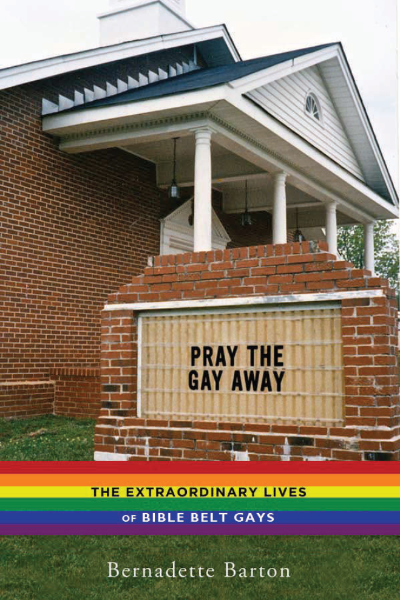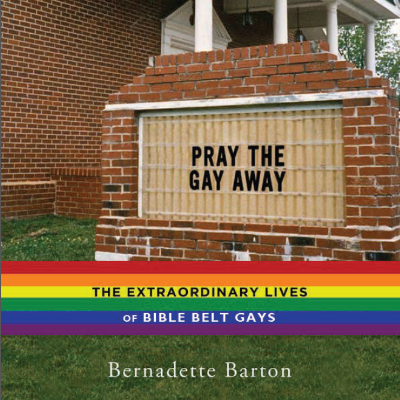 Pray the Gay Away: The Extraordinary Lives of Bible Belt Gays
Pray the Gay Away: The Extraordinary Lives of Bible Belt Gays
Bernadette Barton
New York University Press, 2012
272 pages
By Jami Jones
When it was suspected that Bill was gay, deacons in his Baptist church called a special meeting to decide his church fate. After much discussion they concluded that since they had “no hard proof that Bill was homosexual, they would tolerate him as long as they never had any future reasons to suspect he might be gay.” The pastor spoke with Bill and warned him to avoid associating with “known homosexuals.”
Bernadette Barton, the author of “Pray the Gay Away: The Extraordinary Lives of Bible Belt Gays,” provides an enlightening glimpse into the lives of 59 lesbians and gay men living in fundamentalist Christian communities. Church billboards display a “Gay is not okay” message in America’s Bible Belt region that stretches from Virginia to Florida and through Texas to Oklahoma.
Although homophobia is widespread, it is most concentrated in the Bible Belt that is deeply influenced by a conservative Christian doctrine about homosexuality and the lack of other institutional support for same-sex relationships.
Barton, a professor of sociology and women’s studies at Kentucky’s Morehead State University and a lesbian herself, employed a variety of qualitative methodologies such as in-depth interviews, observations, fieldwork and content analysis of media to understand the experiences of lesbians and gay men living in the Bible Belt. Barton interviewed 36 lesbians and 23 gay men ranging in age from 18 to 74.
The value of reading the stories of older adults is that they could address shifts in Bible Belt attitudes and the impact of their sexual orientation on their lives that may help youth workers see a broader picture that translates into improved support.
Although most participants in Barton’s research described tense family relationships upon coming out that smoothed out over the years, some connections never were repaired. These stories can help youth workers to understand relational ups and down while informing them about the toll of growing up gay and coming out in fundamentalist Christian communities.
Barton sheds light on the dangers of the “toxic closet,” where lesbians and gay men hide their sexual identity for fear of rejection, condemnation, violence and loss of familial relationships and support. Barton found that 22 percent of 59 participants in this research concealed their homosexuality from their parents which led to the disintegration of relationships and an uncomfortable feeling of hiding the truth.
Even at 36, Ron, from Eastern Kentucky, continues to withhold this important part of his life from his parents, believing that if his parents found out they might “harm me, get rough with me, kick me out, withhold their love.” Rejection, condemnation, violence and loss were common experiences among participants during and after the coming-out process.
Readers meet Kelly, a 21-year-old college student from Houston whose mother considers her “dead to me” after learning that her daughter is a lesbian. Even though Kelly’s younger sister declared that she was a lesbian too, Kelly was the only child in the family made to leave.
Joshua is a 29-year-old from Georgia whose parents kidnapped him from college when they learned he was gay. They seized everything from his dormitory room explaining that “they would not equip Joshua with anything that supported a sinful lifestyle.” Barton describes these painful stories without histrionics but forcibly enough for us to realize that being lesbian or gay in the Bible Belt is risky — physically, emotionally, financially and socially.
“Pray the Gay Away: The Extraordinary Lives of Bible Belt Gays” is organized into nine chapters in which Barton presents accounts of family rejection, loss of religion and the toxic closet as well as information about the Bible Belt, homophobia, Christian fundamentalism, the ex-gay movement that seeks to convert lesbians and gay men to heterosexualism and creationism.
Barton concludes the book by using the “talking back” technique developed by bell hooks, a well-known American author and feminist who chooses to use her name in lower case, to elicit responses about “what you would like to say about your life to people who are ignorant about gay people that might create social change?”
These “talking back” comments, Barton writes, surfaced two central premises. That “we all suffer, we all pay our bills and mow the yard, and that if you just understand this, everything would be okay — sounded by 90 percent of the Bible Belt gays I interviewed was tempered by the desire of many that conservative Christians fully comprehend the oppression that gay people endure.”
Barton’s captivating and engaging research invites us to consider the challenges facing lesbian and gay youth living in the Bible Belt. This is a book to be valued by educators, social workers, mental health counselors and others seeking a deeper understanding of the fear and hatred experienced by gay, lesbian, bisexual and transgender youth that will hopefully lead to improved support of gay youth and the development of safe spaces.
Additional reading about this topic:
In “Out in the Country: Youth, Media, and the Queer Visibility in Rural America,” author Mary L. Gray (New York University Press, 2009) describes the findings of her ethnographic research to understand how this population negotiates media and public spaces. Although not as captivating as Barton’s book, Gray provides additional glimpses into the lives of gay teens living in communities with few resources to support them.
“Crisis: 40 Stories Revealing the Personal, Social, and Religious Pain and Trauma of Growing up Gay in America” by Mitchell Gold (Greenleaf Book Group Press, 2008) provides 40 perspectives about the challenges and pain facing gay youth.
“Rapture Practice: My One-Way Ticket to Salvation: A True Story” by Aaron Hartzler (Little, Brown Books for Young Readers, 2013) was selected by members of the American Library Association’s Gay, Lesbian, Bisexual, and Transgender (GLBT) Round Table for inclusion in the Rainbow Project, which is a listing of exceptional books about the GLBT experience. Hartzler recounts his life growing up gay in a conservative community. A listing of Rainbow Project books is available at their website.
The American Library Association’s Stonewall Book Awards is considered the most significant award bestowed on GLBT books for children and teens. These Award books can be found at http://bit.ly/1oSf15F.


























